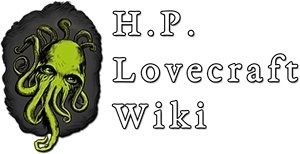No edit summary Tag: Visual edit |
No edit summary |
||
| Line 7: | Line 7: | ||
| first = "[[The Call of Cthulhu]]" |
| first = "[[The Call of Cthulhu]]" |
||
| created by = [[H. P. Lovecraft]] |
| created by = [[H. P. Lovecraft]] |
||
| − | |image = Lovecraft circle Seal.jpg}} |
+ | | image = Lovecraft circle Seal.jpg}} |
'''Francis Wayland Thurston''' is a fictional character created by [[H. P. Lovecraft]], who makes his only appearance in the 1928 short story "[[The Call of Cthulhu]]". He is a Bostonian anthropologist, the grandnephew of [[George Gammell Angell]] and the sole heir and executor of his estate. While going through the late Professor Angell's papers, he discovered the secret of the [[Cthulhu]] Cult, a revelation that probably sealed his doom. |
'''Francis Wayland Thurston''' is a fictional character created by [[H. P. Lovecraft]], who makes his only appearance in the 1928 short story "[[The Call of Cthulhu]]". He is a Bostonian anthropologist, the grandnephew of [[George Gammell Angell]] and the sole heir and executor of his estate. While going through the late Professor Angell's papers, he discovered the secret of the [[Cthulhu]] Cult, a revelation that probably sealed his doom. |
||
Revision as of 16:54, 24 February 2018
Francis Wayland Thurston is a fictional character created by H. P. Lovecraft, who makes his only appearance in the 1928 short story "The Call of Cthulhu". He is a Bostonian anthropologist, the grandnephew of George Gammell Angell and the sole heir and executor of his estate. While going through the late Professor Angell's papers, he discovered the secret of the Cthulhu Cult, a revelation that probably sealed his doom.
Behind the Mythos
- Thurston's name appears only in the story's subtitle, which originally appeared in Weird Tales but was dropped from later reprints until the 1981 Arkham House edition.[1]
- "Thurston" is an old Providence family name. Francis Wayland was the fourth president of Brown University, who did much to build up the institution.
References
- ↑ Joshi, p. 173.
